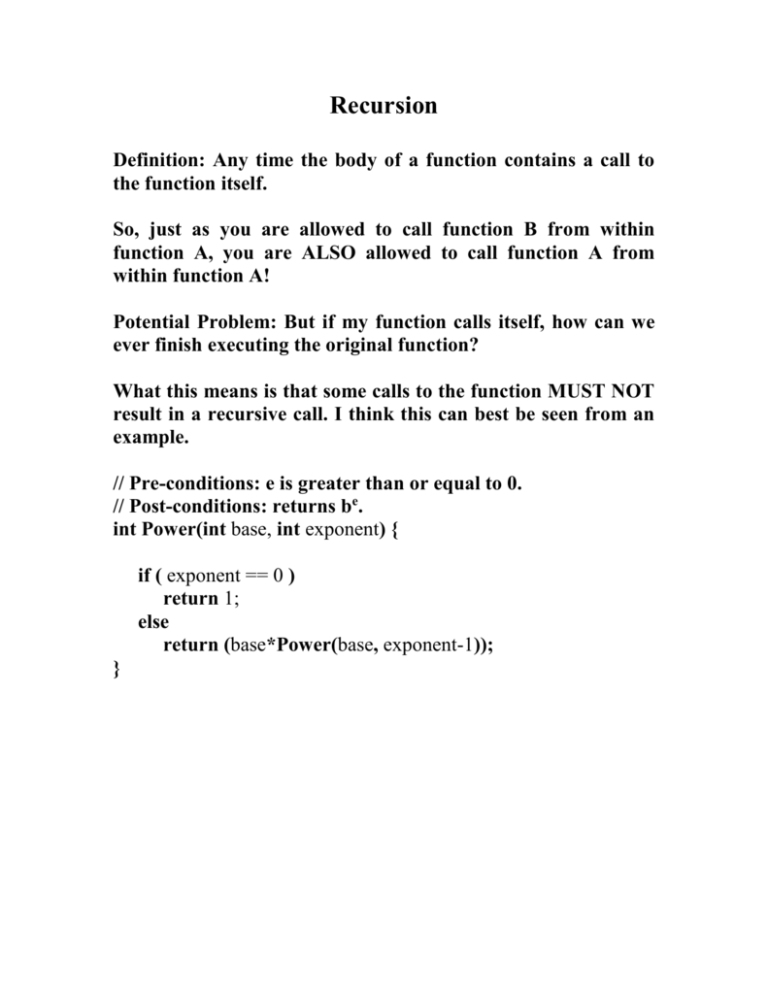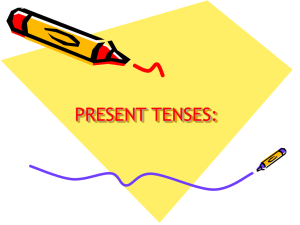Recursion
advertisement

Recursion
Definition: Any time the body of a function contains a call to
the function itself.
So, just as you are allowed to call function B from within
function A, you are ALSO allowed to call function A from
within function A!
Potential Problem: But if my function calls itself, how can we
ever finish executing the original function?
What this means is that some calls to the function MUST NOT
result in a recursive call. I think this can best be seen from an
example.
// Pre-conditions: e is greater than or equal to 0.
// Post-conditions: returns be.
int Power(int base, int exponent) {
if ( exponent == 0 )
return 1;
else
return (base*Power(base, exponent-1));
}
To convince you that this works, let’s look at an example:
Say we were trying to evaluate the expression
Power(5, 2)
Power(5,2) returns 5*Power(5,2-1) = 5*Power(5,1)
To evaluate this expression we must evaluate:
Power(5,1) returns 5*Power(5, 0)
Finally, we have:
Power(5,0) returns 1.
Thus, Power(5,1) returns 5*1, which is 5.
Finally, Power(5,2) returns 5*Power(5,2-1) = 5*5 = 25,
and we are done.
General Structure of Recursive Functions
What we can determine from the example above is that in
general, when we have a problem, we want to break it down
into chunks, where one of the chunks is a smaller version of the
same problem.
(In the case of Power, we utilized the fact that xy = x * xy-1, and
realized that xy-1 is in essence an easier version of the original
problem.)
Eventually, this means that we break down our original
problem enough that our sub-problem is quite easy to solve. At
this point, rather than making another recursive call, directly
return the answer, or complete the task at hand.
So, ideally, a general structure of a recursive function has a
couple options:
1) Break down the problem further, into a smaller subproblem
2) OR, the problem is small enough on its own, solve it.
When we have two options, we often use an if statement. This is
typically what is done with recursion. Here are the two general
constructs of recursive functions:
Construct 1
if (terminating condition) {
DO FINAL ACTION
}
else {
Take one step closer to terminating condition
Call function RECURSIVELY on smaller subproblem
}
Construct 2
if (!(terminating condition) ) {
Take a step closer to terminating condition
Call function RECURSIVELY on smaller subproblem
}
Typically, functions that return values take on the first
construct, while void recursive functions use the second
construct. Note that these are not the ONLY layouts of
recursive programs, just common ones.
Example using construct 1
Let’s write a function that takes in one positive integer
parameter n, and returns the sum 1+2+...+n. (You probably
did this is C numerous times, yet surprisingly it never gets old!)
Step 1: We need to solve this problem is such a way that part of
the solution is a sub-problem of the exact same nature.
Let f(n) denote the value 1+2+3+...+n
Using our usual iterative logic, we have
f(n) = 1 + (2 + 3 + ... + n)
But, 2+3+... + n IS NOT a sub-problem of the form 1+2+...+n.
But, let’s try this:
f(n) = 1 + 2 + ... + n = n + (1 + 2 + ... + (n-1))
So, here we have gotten the expression 1 + 2 + ... + (n-1) which
IS a sub-problem we were looking for. Hence, we have
f(n) = 1 + 2 + ... + n = n + (1 + 2 + ... + (n-1)) = n + f(n-1)
If we look at the construct 1, the first thing we need to
determine is a terminating condition. We know that f(0) = 0, so
our terminating condition can be n=0.
Furthermore, our recursive call needs to be returning an
expression for f(n) in terms of f(k), for some k<n. In this case,
we just found that f(n) = n + f(n-1). So, now we can write our
function:
// Pre-condition: n is a positive integer.
// Post-condition: Function returns the sum 1+2+...+n
int Triangle_Number(int n) {
if ( n == 0 )
return 0;
else
return (n + Triangle_Number(n-1));
}
Let’s compare this to the ITERATIVE version you would have
written in COP3223:
// Pre-condition: n is a positive integer.
// Post-condition: Function returns the sum 1+2+...+n
int Triangle_Number(int n) {
int index, sum = 0;
for (index=1; index <=n; index++)
sum = sum + index;
return sum;
}
Example using construct 2
We must write a function for an example of construct 2. A
couple lectures ago, when I introduced loops, we wrote an
algorithm that printed out a tip chart. We could have just as
easily made that a function that takes in the lowest dollar value
and highest dollar value on the chart. The method header of
the function would look like:
// The function prints out a chart with the appropriate tips
// for meals ranging from first_val to last_val number of
// dollars, for every whole dollar amount. Both parameters
// must be positive integers.
void Tip_Chart (int first_val, int last_val)
Now, let’s consider writing this function recursively.
First, we need to determine a terminating condition. That
seems to be relatively simple: if the lowest dollar amount is
greater than the highest dollar amount, then the chart is empty
and we are done.
Next, we need to figure out how to break down our task into
two steps: one that does part of the job, and secondly a
recursive step.
1) It is clear that the first value we have to print of the chart is
associated with the lowest dollar value, since that must
appear on the chart first. Printing out this line of the tip
chart can be the part of the job we accomplish.
2) Now, are we left with a sub-problem of the same nature?
Yes! We simply now need to print a tip chart from the
lowest dollar value+1 to the highest dollar value.
So, now, we can use these steps to come up with the function:
#define
TIP_RATE
0.15
// Pre-condition: Both parameters are integers with the first
//
one being less than or equal to the second one.
// Post-condition: A tip chart will be printed out, with a row for
//
each dollar amount ranging in between the
//
value of the two parameters.
void Tip_Chart (int first_val, int last_val)
if ( !(first_val > last_val) ) {
printf(“On a meal of $%d”, first_val);
printf(“ you should tip $%lf\n”, first_val*TIP_RATE);
Tip_Chart(first_val + 1, last_val)
}
}
Using a Stack to Trace Recursive Code
A stack is a construct that can be used to store and retrieve
items. It works just like a stack of plates in the cafeteria: The
last plate placed on the top is the first one that must be
removed. Essentially, it’s a Last In, First Out(or LIFO) system.
Stacks can help us trace calls to recursive functions. Consider
computing Power(8,3) using the recursive definition of Power
given in lecture. We can put a line of code from our main
algorithm as the first item on the stack:
Main algorithm: Unfinished: “total = Power(8,3)
Now, we need to compute that value, so the function call
Power(8,3) is placed above this statement in the stack.
Power(1st) b=8,e=3, Unfinished: “Power returns 8*Power(8,2)”
Main algorithm: Unfinished: “total = Power(8,3)”
Now we repeat the process...
Power(2nd) b=8,e=2, Unfinished:“Power returns 8*Power(8,1)”
Power(1st) b=8,e=3, Unfinished: “Power returns 8*Power(8,2)”
Main algorithm: Unfinished: “total = Power(8,3)”
Again...
Power(3rd) b=8,e=1, Unfinished: “Power returns 8*Power(8,0)”
Power(2nd) b=8,e=2, Unfinished:“Power returns 8*Power(8,1)”
Power(1st) b=8,e=3, Unfinished: “Power returns 8*Power(8,2)”
Main algorithm: Unfinished: “total = Power(8,3)”
Finally,
Power(4th) b=8,e=0, returns 1
Power(3rd) b=8,e=1, Unfinished: “Power returns 8*Power(8,0)”
Power(2nd) b=8,e=2, Unfinished:“Power returns 8*Power(8,1)”
Power(1st) b=8,e=3, Unfinished: “Power returns 8*Power(8,2)”
Main algorithm: Unfinished: “total = Power(8,3)”
Now, we are ready to “collapse” the stack:
Power(3rd) b=8,e=1, “Power returns 8*1”
Power(2nd) b=8,e=2, Unfinished:“Power returns 8*Power(8,1)”
Power(1st) b=8,e=3, Unfinished: “Power returns 8*Power(8,2)”
Main algorithm: Unfinished: “total = Power(8,3)”
Power(2nd) b=8,e=2, “Power returns 8*8”
Power(1st) b=8,e=3, Unfinished: “Power returns 8*Power(8,2)”
Main algorithm: Unfinished: “total = Power(8,3)”
Power(1st) b=8,e=3, “Power returns 8*64”
Main algorithm: Unfinished: “total = Power(8,3)”
Main algorithm: “total = 512”
Practice Problem
Write a recursive function that takes in two non-negative
integer parameters, and returns the product of these
parameters.
// Precondition: Both parameters are non-negative integers.
// Postcondition: The product of the two parameters is retrned.
function Multipy returnsa Num (first, second isoftype in Num) {
if (( second == 0 ) || ( first = 0 ))
return 0;
else
returns (first +Multiply(first, second-1));
}
How can we adapt this solution to work for negative numbers?
// Precondition: None
// Postcondition: The product of the two parameters is retrned.
function Multipy returnsa Num (first, second isoftype in Num) {
if ( second < 0 )
return -Multiply(first,-second);
else if ( first < 0 )
return -Multiply(-first, second);
else if (( second == 0 ) || ( first = 0 ))
return 0;
else
return (first +Multiply(first, second-1));
}
Two more exercises for next time:
1) Write a recursive function that determines the nth Lucas
number. Here is the definition of the Lucas numbers:
L1 = 1, L2 = 3, Ln = Ln-1 + Ln-2, for all integers n > 2.
// Pre-condition: n > 0
// Post-condition: Returns the nth Lucas number, Ln.
int Lucas(int n);
2) Binomial coefficients, denoted C(n,k), can be computed as
follows:
C(n,0) = C(n,n) = 1, for all non-negative integers n.
C(n,k) = C(n-1, k-1) + C(n-1, k), for all integers n > 0 with
0 < k < n.
// Pre-condition: n 0, and 0 k n
// Post-condition: Returns C(n,k).
int bin_coeff(int n, int k);








